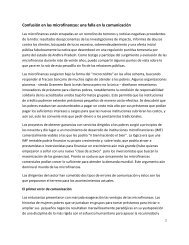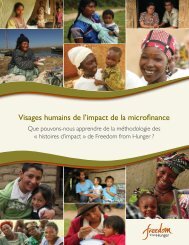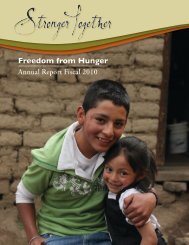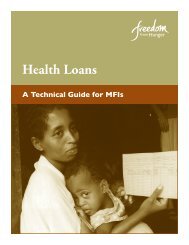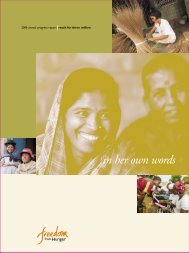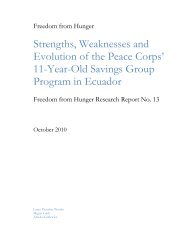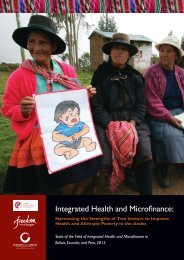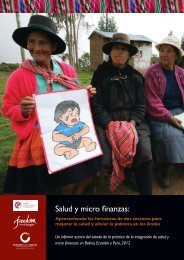history of meals for millions, soy, and freedom from ... - SoyInfo Center
history of meals for millions, soy, and freedom from ... - SoyInfo Center
history of meals for millions, soy, and freedom from ... - SoyInfo Center
Create successful ePaper yourself
Turn your PDF publications into a flip-book with our unique Google optimized e-Paper software.
225. Soypro International Inc. 1969. A study <strong>of</strong> business<br />
prospects in the food industry <strong>of</strong> India. Cedar Falls, Iowa. iv<br />
+ 87 p. Summarized as “Soybeans have good future in<br />
India” in Soybean Digest. 1969. Dec. p. 28. 28 cm. [20 ref]<br />
• Summary: As part <strong>of</strong> The Canadian Food Advisory Team.<br />
For Malwa Economic Development Society (MEDS),<br />
Indore (which has expressed an interest in entering some<br />
aspect <strong>of</strong> the food industry in India). Sponsored by United<br />
Church <strong>of</strong> Canada.<br />
Contents: Objectives <strong>and</strong> guidelines. Part I: Food<br />
resources <strong>and</strong> malnutrition. Food grains <strong>and</strong> pulses.<br />
Calories. Proteins: Legumes, oilseeds, milk, fish, poultry,<br />
meat. Fats <strong>and</strong> oils. Areas <strong>of</strong> food needs: Undernourishment<br />
protein malnutrition. Summary <strong>and</strong><br />
conclusions.<br />
Part II: Food marketing. The non-market. Primary<br />
factors <strong>of</strong> the real market. Guidelines <strong>for</strong> product selection<br />
<strong>and</strong> production. Selling the product.<br />
Part III: What is being done. Food ingredients: Grain<br />
processing, oilseeds <strong>for</strong> human nutrition. Consumer<br />
products: Protein foods <strong>for</strong> infants <strong>and</strong> children, foods <strong>for</strong><br />
general consumption.<br />
Part IV: Prospects <strong>for</strong> <strong>soy</strong>bean production <strong>and</strong> <strong>soy</strong>a<br />
food processing. Production: Yields, crop input, returns in<br />
relation to other crops. Market outlets <strong>and</strong> prices: Domestic<br />
markets <strong>for</strong> <strong>soy</strong> products, estimated prices. Soybean<br />
processing: Processing plants, storage, transportation, plant<br />
investment costs (new plants, converting existing plants to<br />
<strong>soy</strong>bean processing). Low fiber meal <strong>and</strong> <strong>soy</strong> flour:<br />
Investment cost <strong>for</strong> production, marketing. Full-fat <strong>soy</strong><br />
flour. Soy protein isolates. Specialty <strong>soy</strong> foods: Soy milk<br />
<strong>and</strong> related products, <strong>soy</strong>-based snack foods, cereals, dal.<br />
Conclusions.<br />
Part V: Potential projects. Storage. Rice milling. Pulse<br />
milling. Soybean processing <strong>for</strong> <strong>soy</strong> flour, <strong>soy</strong> protein<br />
isolates. Sesame processing. Bread. Baby foods. High<br />
protein mixes. Synthetic milk or base <strong>for</strong> toned milk–related<br />
dairy products. Extruded high protein snacks / cereals. Lowcost<br />
quick-cooking dal. Food marketing <strong>and</strong> distribution.<br />
List <strong>of</strong> references. Appendixes. Population <strong>of</strong> India.<br />
Recent production trends <strong>and</strong> current yields <strong>of</strong> key crops in<br />
India. Rough calculations <strong>of</strong> gross protein availability <strong>from</strong><br />
local production in India.<br />
This practical, business-oriented report focuses on lowcost<br />
high-protein foods designed to help private business<br />
meet India’s problems <strong>of</strong> protein malnutrition, especially<br />
among infants <strong>and</strong> children. “Similarly, with fast rising<br />
interest in <strong>soy</strong>bean production <strong>and</strong> utilization, considerable<br />
early attention had been given to this particular field...” In<br />
1965-66, <strong>and</strong> in 1966-67 India had two devastating drought<br />
years. Prior to this, India has experienced four major<br />
droughts accompanied by famines since 1900: 1907-08,<br />
1918-19 (the worst, with a 32.3% drop in agricultural<br />
MEALS FOR MILLIONS, SOY, AND FREEDOM FROM HUNGER 97<br />
© Copyright Soyinfo <strong>Center</strong> 2011<br />
output), 1920-21 (the second worst; 24.0% drop), <strong>and</strong> 1923-<br />
24 (16.6% drop).<br />
Pulses, mostly in the <strong>for</strong>m <strong>of</strong> dal (“the poor man’s<br />
meat”) have <strong>for</strong> many years been second only to food grains<br />
as a source <strong>of</strong> protein in Indian diets. Most pulses are<br />
dehulled by h<strong>and</strong>-powered stone mills at home be<strong>for</strong>e<br />
cooking, with a wastage <strong>of</strong> about 10%. However pulses are<br />
not keeping pace with the food grains in India’s Green<br />
Revolution. Average yields are relatively low <strong>and</strong> response<br />
to fertilizer is low. Per capita consumption is static, or<br />
declining. India’s main oilseeds in 1967-68 were (in<br />
descending order <strong>of</strong> output in million metric tons):<br />
groundnuts in the shell (5.83), cottonseed (2.00), rapeseed<br />
<strong>and</strong> mustard (1.48), sesame (0.42), <strong>and</strong> niger seed (0.10).<br />
Only groundnut, sesame, <strong>and</strong> niger also provide significant<br />
amounts <strong>of</strong> protein <strong>for</strong> humans. Yet after the oil is removed,<br />
most <strong>of</strong> the protein-rich oilseed cakes are used in livestock<br />
feeds or fertilizer, or exported; only about 10% <strong>of</strong> the<br />
available protein is used directly in human diets. There is<br />
now much interest in using more groundnut protein (as flour<br />
or isolate) in human foods; it has been used in toned milk.<br />
India’s major source <strong>of</strong> animal protein is milk (both <strong>from</strong><br />
water buffaloes <strong>and</strong> cows), with per capita daily<br />
consumption being 123 gm (4.4 oz).<br />
Relatively little red meat is consumed in India; many<br />
states prohibit slaughter <strong>of</strong> cows. Goats <strong>and</strong> water buffaloes<br />
are the major sources <strong>of</strong> meat. According to CFTRI, 39% <strong>of</strong><br />
Indians are deficient in proteins, <strong>and</strong> a high proportion <strong>of</strong><br />
these are infants <strong>and</strong> children. Per capita availability <strong>of</strong> oils<br />
is 9.3 lb/year. 70 to 75% <strong>of</strong> all food produced stays on the<br />
farm <strong>and</strong> is consumed directly by the producers. Wheat is<br />
the main grain in north India, <strong>and</strong> rice in south India. About<br />
25% <strong>of</strong> Indians are vegetarian by conviction, <strong>and</strong> “75% are<br />
now willing to eat animal products, with the latter<br />
percentage increasing every year. In practice, diets are still<br />
largely vegetarian because <strong>of</strong> the scarcity <strong>and</strong> cost <strong>of</strong> animal<br />
products.” Prestige is the single most important marketing<br />
factor in part because India is still a highly class-conscious<br />
society. The market is highly segmented. Products need to<br />
be targeted separately at the top 3 or 4 <strong>of</strong> the 5 class<br />
segments. The high class line should be introduced first.<br />
Cheap food or “food <strong>for</strong> the poor” has little chance <strong>of</strong><br />
succeeding in commercial channels. Except as food <strong>for</strong><br />
children, it is very hard to sell food on the basis <strong>of</strong> its<br />
nutritional or health-giving benefits. Sampling is the most<br />
effective promotional technique.<br />
Several companies produce dried baby foods <strong>from</strong> milk<br />
<strong>and</strong> sell them in tin cans. In 1968 the biggest seller was<br />
Amul (3,500 to 3,800 tons), made by Kaira Dairy Coop.<br />
The pioneer commercial weaning food in India was Farex,<br />
made by Glaxo <strong>and</strong> sold in tins at Rs. 13 per kg. Kaira<br />
Dairy Coop launched Bal-Amul at Rs. 11 per kg <strong>and</strong> now<br />
produces 1,000 tons/year, expected to grow to 5,000 tons by<br />
1974. Bal-Amul contains about 25% full-fat <strong>soy</strong> flour, 25%



